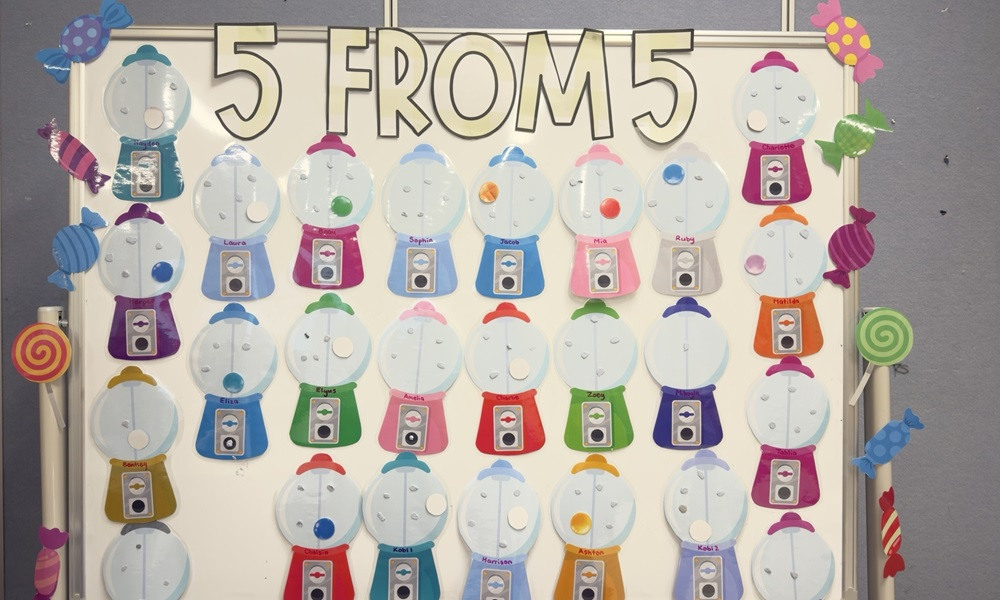Thanks for downloading this podcast from Teacher. I’m Dominique Russell. Today’s episode in our School Improvement series is all about attendance. The impact of student attendance is well known – we know that every day counts for student attendance and we also know the important role that the students themselves, and also their families and school staff all play in supporting high attendance rate.
My guest today is Chantel Barnes. She’s Principal at Glenora District School in the rural town of Glenora outside Hobart, Tasmania. It’s a small K-12 school, and they’ve made some incredible progress on attendance in the past 12 months. Chantel is going to tell us all about how they’ve achieved this, the initiatives that are making a difference in their setting, and her advice for other schools out there. A quick note on terminology before we jump in – you’ll hear Chantel mention the school’s MTSS Framework – that stands for multi-tiered system of supports. Let’s get started!
Dominique Russell: Thanks for joining us on the Teacher podcast, Chantel. So, today we're going to be talking about how you ‘flipped the script’ on attendance at Glenora District School down in Tasmania. But, before we get into the details of all the fantastic work that you're doing, I thought it would be useful to take a little bit of a step back and I'd love to hear about the school context there at Glenora District School. So, can you tell me a little bit about that?
Chantel Barnes: Well, firstly, thanks for having me on the podcast. Well, we're a school in the Upper Derwent Valley in Tasmania, where the buses roll in every morning. About 90% of our kids get to school this way, and some of them are actually commuting for up to an hour, which is a fair effort when you think about it – by the time the first bell rings, they've already done a commute longer than most adults. And yet they're still turning up every day.
And I like to think of it as, there’s a real sense of belonging, connection and purpose here at Glenora, where learning, engagement and improvement matters. And as a principal, my mantra has always kind of been the students cannot be what they cannot see. And it's up to us as educators to open the doors and create opportunities so that every student can make informed decisions or choices about their future beyond school.
We're a really small rural K-12 site with 200 students and 120 families. It's this beautiful 95-year-old school, one hour out of Hobart. And when I became principal last year, a lot of my friends would say: ‘Oh, you're at that school with a really beautiful garden on the way to Mount Field’. And they’re sure right, our garden is something really, really special, but that also transcends through our corridors and into our classrooms.
So, I've been principal here for one full year now. I started in term 3 in 2024, but I've been in education for over 2 decades and I've led teams in attendance and engagement and looking at ways we can improve that across the schools I've worked in and across the system. So, yeah, it's been really lucky.
But what makes Glenora really special is our people: our students, our staff and our families. And we've just had a recent external school review where our families kind of talked about that they really value that they're a true partner in education around their child, and they spoke really highly of how their children are known and supported by our teaching staff here and other adults. And the students, well, they know they're cared for, they're challenged and they're celebrated. And we really do look for those opportunities, I think, to celebrate the quick wins with them all the time. So, at Glenora, our North Star is clear – every student is known, safe, well and learning. That's our anchor, whether it's in reading, wellbeing, and as we'll talk about today, it's about flipping the script on attendance.
DR: And so, let's get into that now then. Again, starting from the beginning, when did your work really begin on attendance and why was that identified as an area of improvement?
CB: Well, when I arrived, attendance work was already happening. It was one of the school priorities and I think it was a really great opportunity for me to really sharpen what the school had been doing. I kind of brought this ‘5 from 5’ initiative that I’d just started at my school prior to coming and had trialled it with a group of grade 8s at that school and had seen some really quick wins and impact that that initiative could have.
I think when we talk about attendance with staff or with students, we've historically talked about percentages. And you know, ‘you're at the 80th percentile for attendance’ or ‘you're at the 70th percentile for attendance’. And staff will often say, ‘what does that mean?’ Or students will say, ‘what does that mean?’ And so, it doesn't really translate. So just, I don't know, one day I was just thinking on that a little bit more after years and years of doing this and I'm like, 5 from 5, Monday to Friday. That makes sense. It's really easy for students to understand schools in days rather than in percentages.
And so, when I got here, we looked at the whole school data and I kind of noted that our K-6 data was really strong. So, in our primary sector the attendance was just right up there. But then we noted that the high school wasn't doing as well. And then that was kind of the turning point where we kind of, I guess, changed the narrative around chasing absences and looked to shift the culture. So, rather than staying stuck in this deficit lens, that we can do with attendance, we flipped the script to, you know – I often talk about seeing the glass half full rather than glass half empty. And so, we really started to focus on belonging, predictable and consistent routines for our kids; and that makes showing up easy and a positive choice for them.
And so, we've kind of put the data in the kids' hands: ‘Here's your attendance data. Here's your days that you've been attending across your school career so far’, so to speak. And every student knows that. And it's not a percentage anymore, it's actually the days across the school year, so they can actually see what it really means. Rather than ‘I'm attending 85% of the time’. We've built an MTSS [multi-tier system of supports] framework where tier one is that whole school belonging and about consistency through the 5 from 5. I work with our professional support staff to really then look at the tier 2 or tier 3 or tier 4 students and the supports that we can offer them, and their families, and we often get the families in at that level to actually then unpack what their attendance means in days as well.
Across our school, every kid has an attendance goal-setting plan, which we review each term –and so the kids will get that as a percentage for them, the days in which they've attended. So, for example, this term's a 50-day term, so we've got, you know, 10 weeks of 5 from 5 and the students will set a goal around that and that's reviewed. We try not to get stuck on historical attendance patterns. So, we don't dwell on that, and instead we just kind of shift our focus to small, achievable steps. And I often – you'll hear the kids might even tell you or the staff will tell you that it's not about, you know, ‘biting the whole apple’, it's about small bites of the apple. Because I think we can, with goal setting, can often get caught up on ‘let's look for a 10,15% improvement’. But I think after doing work and attendance engagement for so long, it's just really unachievable. And so, let's talk about, ‘let's just look for 5% improvement’. You know, that's an extra day a week. We look for those incremental wins for students to build on and it’s really about that sense of accomplishment or achievement.
We see this moving through our school. Students will quite eagerly come up to you and say now: ‘I've had a 5 from 5’ or ‘This week I'm on a 5 from 5 streak of 3’. So, it's been really kind of encouraging or affirming that kids are now kind of really excited that they've had a full week at school. And I think that that's something to be really proud of for our staff and as leading this work. And like I said, I've been leading attendance and engagement for across the 21 years that I've been an educator. And the evidence is clear that in low SES or rural contexts especially, attendance and achievement are so deeply connected. And if students aren't here, they can't learn. But because our kids have been coming more regularly now and are here, we've also got a reading priority happening. And it's been so awesome to see that because they're here more, they're able to get the tier 2 or tier 3 support with their reading and we've actually seen 113 kids grow in their reading accuracy this term, or this year, as well.
So, I think that that's really important that both of our priorities are now working and we're seeing that students can access the supports that they need in terms of academic achievement as well. So, there's a really nice correlation between our 2 priorities and they're both working. So, for me it's really about always keeping the main thing, the main thing. We are invested in the data, we name the gaps and then we work together with staff, the students and their families to change the story.
DR: So, like we've been saying so far, you've been flipping the script on attendance, which is very appropriate because like you've alluded to, a lot of the work is actually around the language specifically when we talk about attendance. So, can you talk me through some of the other changes you've made in terms of how you speak about attendance at school and why was that a crucial thing for you to do?
CB: Yeah, I think when we talk about flipping the script on attendance, it really does come down to that language. And in the past, I think schools or the schools that I've worked in, we've often looked at it at that deficit lens of, ‘student X is away again’, and it becomes that real negative loop. So, we wanted to change that. So instead of focusing on absence, we focus on presence now. We celebrate students turning up: ‘Great to see you today. That's a 3 from 3 so far. Let's make it a 5 from 5 this week’. Every day attendance is broken down into simple, relatable language. So, 5 from 5 means a full week at school. At the start of each term we map it out. So, like I said before, term 3 has 50 days, which is 10 lots of 5 from 5, so students can see it, name it and own their own data for that term.
We've really supported our staff to use that common and consistent language which matters, because it reduces those mixed messages and builds predictable expectations across our whole school. And you'll see our teachers talking with students about 5 from 5 every day; students proudly moving their token on their classroom display wall in the morning – so it's not just about data in the end, it's about that little dopamine hit that we get when I get to put my token in my gumball machine, which is one of our displays.
And I think the best part is that our families have also picked up on that common language as well. So, they'll often come in and say, ‘I've got to take them out for an appointment. They're going to mess up their 5 from 5 streak this week’. But around the valley, you'll hear parents using the 5 from 5 language, because kids are coming home celebrating their attendance. That shift in language has created a shared narrative – students, staff and families all speaking the same way about attendance, not as a negative, but a point of pride.
DR: And so, we've spoken a lot already about the 5 from 5 initiative. I've got a good grasp of what it is, but I'm conscious of the listeners who maybe are thinking that this is something that might potentially work fantastically in their school setting. Is there any other detail you'd like to share on that initiative and also, you know, any more about the impact that it's having at your school?
CB: Yeah, well, we've built a whole school MTSS framework around it. So, in our PL [professional learning] room, we do have a visual data wall which staff do track. And each term we identify students that might need a little bit more support. And in our classrooms – it doesn't matter which classroom you walk into right now – there's a visual 5 from 5 data wall. So, some of our teachers have co-designed this with their classes. And so we've got gumball machines where, like I said before, students drop a gumball into their machine daily. We've got one around fishing where you catch a fish each week. And then we've got a footy scoreboard one where you kick a goal every day you come to school, and you go into the mix for a Brownlow medal. So, each term those displays are reset so everyone has a fresh start.
And then at the end of the week I'll share out an attendance percentage for classes and we have a bit of a tally board going on. I've learnt that my staff are very competitive about this and at the end of each term we give out $100 cheque that goes to the class that's had the best attendance and so that goes back into their budget to do something fun.
Each term we do look at patterns though – 5 from 5 equals 25 consecutive days where students engage in excursions that grow their comfort zones. So, we've taken the kids on activities like dragon boat racing; so they've got into the old Viking boats if they've had 25 consecutive days across the school term. So, that might look like week 3 to 8, it might like look like week one to 5. But across the term we’re looking for a pattern of 25 and then they get to go and do something that, you know, stretches their comfort zone bubble to extend them a little bit more and it just keeps the motivation high. And so that's worked really well.
And I think the impact has been pretty tangible. When we've flipped the script we now have our high school kids outdoing our primary in terms of data – we've seen an actual 10% growth from this time last year in terms of our high school students and they're quickly closing the gap on the state average as well. Even more importantly, you know, the number of kids attending 90% of the time has also improved across our school. So, we know that there's been a 16% improvement since this time last year, in 2024, for our high school kids being here above 90%. And just last term we have had 106 students [increasing] to 135 here 100% of the time. So, it's pretty cool.
So, it's not just that catchphrase, it's a whole framework that's really kind of shifted our attendance culture here, and it's kind of lived and breathed by everyone.
DR: Absolutely. And so, it's obvious that data is such a crucial part of the work. Can you talk me through what kind of data you're, you know, collecting on attendance and also who you're sharing it with? Because it's clear that the school community is really tight knit there, and that the parents would be really interested in this data too, as well as the students, right?
CB: Correct. Yeah. So, knowing the data is really, really important. And I think being across the data – from leaders through to teachers, through to students, all know the data. And so, it doesn't just sit at the hands of the adults, it sits at the hands of the students.
We track our data at 3 different levels, I guess: we track it at the whole school level; we then track it at classroom level; and then kids are tracking it at their own individual level as well. And that means we can kind of see the big picture trends, but we can also zoom in to individual students who might need that extra support. We share the data weekly with staff, families and students, and those attendance goal setting sheets go home to our families each term so that they can see. And that kind of builds the transparency and accountability and also, again, strengthens that language that everyone's on the same page.
And like I said before, the data's up on the walls each day, each week, and you know, it's just become – I think that visual data story part is really, really powerful of seeing it and it's done in a really, really safe way. Like it's not, you know – whilst over in our PL room, it's an MTSS framework and it's in the percentage tiers, in the classroom it's just your own individual sheet and it might be reset at the end of the week. So, it's not this, you know, ‘I've only got below 70% attendance’. It's actually really kind of taken, I guess, the shame part out of it, as in ‘I'm not here, I have barriers’. It's really around each individual kid has their own name, but they're catching fish and it's about their net rather than where everyone else is. So, I think that that's also really important to know, because I think that when schools potentially fear away from putting the data with kids up visually, we do kind of worry about what that might be perceived as by other students. But yeah, we've really done it in a really safe way that it's not really, ‘I'm against someone else’. It's really, you know, ‘I'm running this. I'm running my own race. I'm not running someone else's’. So that's been really important when we talked about data as well.
So, it's not just leadership looking at spreadsheets. It's a whole school culture of collecting, sharing and celebrating data together. And I think that's a really, really important bit, is that we're really focused on celebrating, celebrating and celebrating the wins with the kids at class level, at individual level, at whole school level. And yeah, we do share that data with our families out on Facebook around – look at this, you know, tremendous growth we've had – and it's been really awesome that our families are talking the same language and talking positively about attendance and being here, and that every day does matter to be a part of the school community.
DR: And so what's next then, for your work on attendance? You've had so much success in such a short time, really. Do you have any future goals or plans that you're working on at the moment?
CB: Well, in true Chantel form, it's around staying the course. It's not about, ‘we've done that really well, now let's take that off the agenda’. It's about sustaining. And like you just said, we're only one year into the initiative, really, so it's about now continuing that culture shift.
It's about deepening student voice into it as well. Students, you know, putting ideas back onto the table around attendance and how we can do things better because I think they're a really, really important part, as are families. We'd really like to start linking attendance to pedagogy and future pathways around employment and training and aspiration. We really want to continue to align the work with our reading improvement as well, attendance and engagement and achievement overall. And again, Glenora Way known for high expectations and strong relational culture.
So yeah, I think it’s just really now keeping that main thing, the main thing. I just often I think we can say, ‘oh, we're doing really well in that, let's take the foot off the gas’. But it's really about now, how do we keep doing it better? And like I said, the input of staff and students to keep evolving it over the next, I don't know, 3-5 years, knowing that sustained change takes that long.
DR: And so, the final question that I wanted to ask you then, Chantel, is for teachers and leaders around the country who are going be listening to this episode, who for them attendance may be an identified target perhaps for the upcoming school year. Do you have any words of advice to share?
CB: Definitely start with the language. You know, it's pretty catchy, ‘5 from 5’. Words matter and they have shaped our culture here. It's about, you know, keeping the language really simple and involving students, staff and families so that the strategy is co-owned.
And again, like I think I've said before, it's really about celebrating those small wins, so we get the momentum that really has mattered for us. Again, glass half full rather than glass half empty. We can really get caught up on attendance is trending down, but let's look at ways to trend it up. So, using data for visibility – it's not blame, it's about showing progress and patterns or looking for those patterns of where we can actually support our young people. And making it everyone's business.
And if there's anything I've learned, it's about go slow to implement well and that sustained change takes time. And it's just about how we now keep building that momentum and moving forward.
DR: Great words to end on. Thank you so much, Chantel. It's been a pleasure to have you on the podcast.
CB: Thank you for having me. I've really, really enjoyed it.
That’s all for this episode. Thanks for listening. If you enjoyed the episode, please take a quick moment to hit follow on your podcast app (if you haven’t already) and leave us a review. Both of those things help more people like you to find our podcast and they’re a big help to our team. We’ll be back with a new episode very soon!
Related reading
Chantel Barne’s blog shares more information on the school's work on attendance.
Chantel Barnes says it’s important to start with language when it comes to student attendance. Reflect on the language you use when talking about student attendance. Is attendance spoken about through a deficit lens? How could you move to focusing on student presence, rather than absence?
When it comes to implementing initiatives to support student attendance, have you invited students to put their ideas forward? How could you deepen student voice around attendance conversations?



